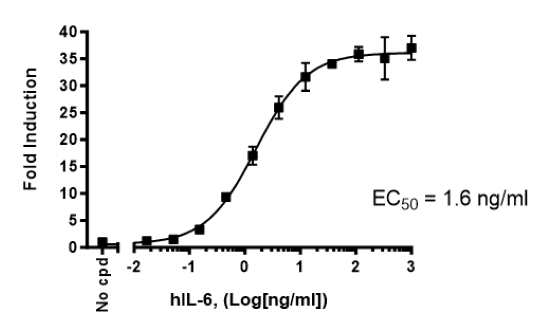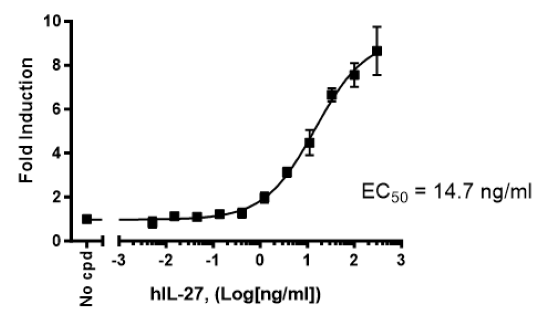IL-6 Responsive Luciferase Reporter HEK293 Cell Line
IL-6 Responsive Luciferase Reporter HEK293 Cell Line is a HEK293 cell line designed to monitor the IL-6 (interleukin 6)/IL-6 receptor interaction. These cells express endogenous IL-6 receptor (IL-6R and gp130) and were engineered to express firefly luciferase under the control of a STAT response element (Figure 1).
This cell line has been validated to respond to human interleukin-6 (IL-6), IL-27, and further functional validation experiments showed that IL-6-induced luciferase activity was decreased by the JAK inhibitor CP 690,550 and by an anti-IL-6R neutralizing antibody.

Figure 1: Illustration of the mechanism behind reporter expression in IL-6 Responsive Luciferase Reporter HEK293 Cell Line.
Purchase of this cell line is for research purposes only; commercial use requires a separate license. View the full terms and conditions.
Materials Required for Cell Culture
| Name | Ordering Information |
| Thaw Medium 1 | BPS Bioscience #60187 |
| Growth Medium 1N | BPS Bioscience #79801 |
Materials Required for Cellular Assays
| Name | Ordering Information |
| Human IL-6 | R&D Systems #206-IL |
| Human IL-27 | R&D Systems #2526-IL |
| JAK inhibitor CP 690,550 | Cayman #11598 |
| Anti-IL-6R Antibody | R&D Systems #MAB227 |
| Assay Medium: Thaw Medium 1 | BPS Bioscience #60187 |
| 96-well tissue culture white, clear-bottom assay plate | Corning #3610 |
| ONE-Step™ Luciferase Assay System | BPS Bioscience #60690 |
| Luminometer |
The cell line has been screened to confirm the absence of Mycoplasma species.
IL-6 (interleukin-6), instantly produced at the site of inflammation, plays a critical role in host defense through the stimulation of acute phase responses, hematopoiesis, and immune reactions. IL-6 exerts stimulatory effects on T- and B-cells, by acting on the STAT3 (signal transducer and activator of transcription 3) signaling pathway. Dysregulated IL-6 expression shows a pathological effect on chronic inflammation, autoimmunity and cancer. Il-6 expression is regulated at multiple levels, with transcription being induced by several types of stimuli, such as TLR (Toll-like receptor) ligands, TNFα (tumor necrosis factor alpha) and ROS (reactive oxygen species). IL-6 is also involved in cell senescence and can trigger senescence-induced inflammation and age-related diseases. The use of the anti-IL-6R antibody tocilizumab has resulted in positive outcomes in the treatment of RA (rheumatoid arthritis) and Castleman’s disease. Hence, the development of molecules able to target the IL-6 and IL-6 signaling pathway is an active area of research and can be an effective strategy for prevention and treatment of chronic inflammatory diseases and cancer.
Tanaka T., et al., 2014, Cold Spring Harb Perspect Biol. 6(10):a016295.
Choy EH., et al., 2020, Nature Rev Rheumatol. 16:335-345.
Hirano T., 2021 International Immunology 33(3):127-148.





